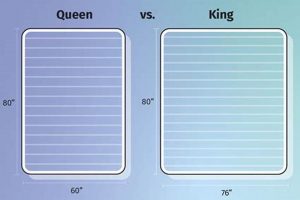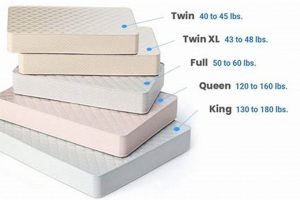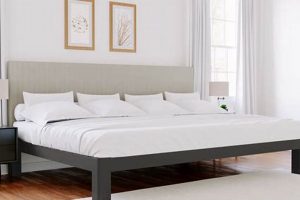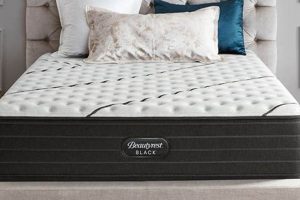A large sleeping surface, measuring approximately 76 inches wide by 80 inches long, offers ample space for individuals or couples. A distinguishing feature is an additional layer of cushioning sewn onto the top, providing enhanced comfort. This extra padding, often composed of materials like fiberfill, memory foam, or latex, creates a soft and plush feel. For example, someone seeking a more luxurious sleep experience might opt for this type of bed to alleviate pressure points and improve overall rest.
The increased comfort can contribute to better sleep quality, potentially reducing tossing and turning throughout the night. Historically, this design evolved from efforts to improve the sleeping experience beyond the standard innerspring mattress. The additional layer can also prolong the lifespan of the underlying mattress by absorbing some of the wear and tear. The larger size caters specifically to individuals who desire more personal space while sleeping or couples seeking to minimize sleep disturbances caused by movement.
The following sections will delve into the specific materials used in their construction, explore the range of firmness options available, and provide guidance on selecting the optimal model for individual needs and preferences, as well as proper care and maintenance to ensure longevity.
Selecting and Maintaining a Pillow Top King Size Mattress
The following recommendations offer guidance on choosing and preserving a substantial investment in enhanced sleep comfort.
Tip 1: Assess Firmness Preferences: Before purchase, determine the optimal firmness level. Individuals with back pain may benefit from a firmer surface, while those seeking pressure relief might prefer a softer feel. Test different firmness levels in-store or review online specifications regarding firmness ratings.
Tip 2: Consider Material Composition: The materials used in the pillow top layer impact comfort and durability. Memory foam provides contouring support, while latex offers a more responsive feel and breathability. Fiberfill provides a softer, less expensive alternative. Analyze the properties of each material to match personal preferences.
Tip 3: Evaluate Edge Support: Adequate edge support prevents sagging and maximizes the usable sleep surface. Examine the mattress’s edges to ensure they are firm and resist compression. Strong edge support is especially crucial for couples sharing the bed.
Tip 4: Inspect Stitching Quality: The stitching connecting the pillow top layer to the underlying mattress influences longevity. Closely inspect the stitching for tightness and evenness. Poor stitching can lead to premature separation and reduced comfort.
Tip 5: Utilize a Mattress Protector: A waterproof mattress protector shields against spills, stains, and allergens. This preventative measure extends the lifespan and maintains the hygiene of the sleep surface. Select a protector specifically designed for this type of mattress.
Tip 6: Rotate Regularly: Rotating the mattress every three to six months helps distribute wear evenly and prevent impressions from forming. Following the manufacturer’s recommendations for rotation is essential.
Tip 7: Maintain Proper Support: Ensure the bed frame provides adequate support to prevent sagging. A center support beam is crucial for king-size mattresses to distribute weight evenly. Inadequate support voids warranties and reduces comfort.
Implementing these tips ensures a well-informed purchase and promotes the long-term enjoyment and value of the sleep investment.
The subsequent sections will address common misconceptions and provide a comprehensive overview of warranty considerations.
1. Size and Space
The dimensions and available area of a sleeping surface are paramount factors in determining comfort and sleep quality. A pillow top king size mattress, specifically, addresses these needs by providing substantial space and integrating a comfort-enhancing design.
- Expansive Surface Area
A king-size mattress offers approximately 76 inches in width and 80 inches in length, providing ample space for couples. This minimizes sleep disturbances caused by movement and ensures each individual has sufficient personal space. Couples who value undisturbed sleep often find the dimensions advantageous.
- Accommodation of Larger Individuals
The larger dimensions accommodate taller or larger individuals who may find standard-size mattresses restrictive. Adequate legroom and overall space contribute to improved sleep posture and reduced discomfort. A tall person could therefore enjoy sleep on a king size mattress.
- Enhanced Comfort and Movement
The pillow top layer, combined with the generous dimensions, allows for greater freedom of movement during sleep. Individuals can change positions without feeling confined or disturbing a partner. It ensures better airflow as well as better pressure distribution.
- Aesthetic Considerations
The sheer size of a king-size mattress can visually dominate a bedroom. Rooms must be of sufficient size to accommodate the bed comfortably without overcrowding the space. Size and decor are an important part in sleep
In summary, the size and space afforded by a pillow top king size mattress significantly impact sleep quality and comfort. These dimensions cater to couples, larger individuals, and those seeking unrestricted movement during sleep, provided the bedroom space is adequately sized.
2. Enhanced Comfort Layer
The enhanced comfort layer is a defining characteristic of a pillow top king size mattress, fundamentally altering its surface feel and overall sleeping experience. This layer, typically composed of materials such as fiberfill, memory foam, or latex, is affixed to the top surface, creating a cushioned barrier between the sleeper and the underlying support core. The effect is a noticeable increase in initial plushness and a reduction in pressure points, particularly at the shoulders and hips. For example, an individual experiencing joint pain might find significant relief from the conforming properties of a memory foam pillow top, compared to a traditional innerspring mattress.
The composition and density of the comfort layer directly influence its performance. A thicker layer of high-density memory foam will provide greater contouring and pressure relief than a thin layer of fiberfill. Furthermore, the quality of the materials impacts durability. A latex comfort layer, while potentially more expensive, generally exhibits greater resilience and longevity than synthetic alternatives. The practical significance lies in matching the comfort layer material to specific sleep needs and preferences. For instance, hot sleepers might prefer la
tex or a gel-infused memory foam to mitigate heat retention, while side sleepers could prioritize a thicker, more conforming layer to cushion the shoulders and hips.
In summary, the enhanced comfort layer is an integral component of the pillow top king size mattress, directly contributing to its enhanced comfort and pressure relief. The choice of materials, density, and thickness of this layer are critical considerations in selecting a mattress that meets individual sleep requirements. Understanding the properties of different comfort layer materials allows for a more informed purchase and potentially a more restful sleeping experience. The challenge remains in objectively assessing these properties, often requiring in-store testing and careful review of product specifications.
3. Support and Alignment
A pillow top king size mattress presents a complex interplay between comfort and structural support. The primary function of any mattress is to maintain proper spinal alignment throughout the night, preventing back pain and promoting restorative sleep. The addition of a pillow top layer can potentially compromise this support if not carefully engineered. The underlying core of the mattress, typically composed of innersprings or dense foam, is responsible for providing the necessary foundational support. For example, if the support core is insufficient, the sleeper may sink too deeply into the mattress, negating the benefits of the pillow top and potentially causing spinal misalignment. Thus, the effectiveness of a pillow top design is directly contingent on the robustness of the underlying support system.
The practical significance of understanding this relationship lies in making informed purchasing decisions. Individuals with pre-existing back conditions, for example, should prioritize models with reinforced support cores, even if it means sacrificing some of the initial plushness of the pillow top. Conversely, individuals with a preference for a softer sleeping surface must ensure that the chosen mattress offers adequate support to prevent long-term discomfort. Some manufacturers incorporate zoned support systems, where different areas of the mattress are engineered with varying degrees of firmness to accommodate different body weights and sleeping positions. The location of support can significantly affect individual sleep.
In conclusion, the connection between support and alignment is critical when evaluating a pillow top king size mattress. The presence of a comfort layer should not overshadow the importance of a robust and well-engineered support core. Careful consideration of individual needs, combined with a thorough assessment of the mattress’s structural integrity, is essential to ensure both comfort and proper spinal alignment, challenging the notion that pillow tops are only good for softness.
4. Material Composition
The material composition of a pillow top king size mattress directly dictates its comfort, durability, and overall suitability for various sleep preferences. The selection of materials used in both the pillow top layer and the underlying support core determines the mattress’s ability to provide pressure relief, maintain spinal alignment, regulate temperature, and resist wear and tear. For instance, a pillow top composed of high-density memory foam will conform closely to the body, offering superior pressure relief compared to a fiberfill alternative, however, it might also retain more heat. Similarly, an innerspring core will provide a different support feel compared to a high-density foam core, affecting the mattress’s overall firmness and motion isolation properties. The practical consequence of understanding this is selecting a mattress that aligns with individual needs, a combination core can be ideal.
The long-term performance and lifespan of the mattress are intrinsically linked to the quality and resilience of its materials. A mattress constructed with high-quality latex in the pillow top and high-gauge steel coils in the support core is expected to outlast a mattress made with low-density polyurethane foam and low-gauge coils. Furthermore, the breathability of the materials impacts temperature regulation, influencing sleep quality. Natural materials like cotton and wool promote airflow and moisture wicking, while synthetic materials may trap heat and moisture. An additional example is a mattress with gel-infused memory foam that is intended to mitigate the heat retention typically associated with memory foam.
In summary, the material composition is a critical determinant of the pillow top king size mattress’s performance and longevity. A careful assessment of the materials used in both the pillow top and support core, considering factors such as comfort, support, durability, and temperature regulation, is crucial for making an informed purchase. The challenge lies in discerning the true quality of materials, as marketing claims may not always accurately reflect real-world performance, emphasizing the need for thorough research and potentially consulting with experts.
5. Durability Expectations
The anticipated lifespan is a significant consideration when investing in a pillow top king size mattress. The construction method inherently introduces a potential point of failure: the seam connecting the pillow top layer to the underlying mattress. Repeated compression and movement can strain this seam, potentially leading to separation or uneven wear over time. The quality of materials used in both the pillow top and support core directly influences longevity. For example, a mattress with a low-density foam pillow top may degrade more rapidly than one using high-density latex. Similarly, an innerspring mattress with low-gauge coils may lose support more quickly than one with high-gauge coils or a dense foam core. These factors directly impact the bed’s capacity to provide continued comfort and support throughout its intended use.
The choice of materials and construction also impacts the mattress’s resistance to sagging and indentation. Over time, all mattresses will exhibit some degree of body impressions, but the rate and severity of these impressions are directly correlated with the materials’ quality and density. For instance, mattresses with memory foam pillow tops are particularly susceptible to body impressions if the foam is of low density. Regular rotation of the mattress can help distribute wear more evenly and prolong its lifespan, but it cannot fully mitigate the effects of inferior materials. Furthermore, the presence of a mattress protector can shield the mattress from spills, stains, and allergens, contributing to its overall durability and hygiene. Durability can also effect the warranty period.
In summary, durability expectations for a pillow top king size mattress are influenced by material quality, construction techniques, and maintenance practices. While the pillow top design offers enhanced initial comfort, it also introduces a potential weak point. A careful evaluation of material density, seam construction, and support core strength is essential for selecting a mattress that will provide lasting comfort and support. Managing expectations, understanding that pillow tops can degrade faster is important.
6. Budget Consider
ations
The acquisition of a pillow top king size mattress necessitates careful budgetary planning, as costs can vary significantly based on materials, construction, and brand reputation. The initial price represents a substantial investment, directly correlated with the quality and features offered. For instance, a mattress incorporating natural latex and individually wrapped coils will invariably command a higher price point than a comparable model utilizing synthetic foam and a traditional innerspring system. Failure to adequately assess budgetary constraints may result in compromising on essential features, potentially leading to dissatisfaction with comfort or durability in the long term. Conversely, overspending without considering long-term value can result in unnecessary financial strain. The impact of budget is very important for purchase process.
Long-term costs associated with ownership, such as the need for a supportive bed frame, mattress protector, and potential replacement due to wear and tear, should also be factored into the budget. High-quality bed frames designed to support the weight of a king-size mattress are essential to prevent sagging and premature degradation, representing an additional upfront expense. Furthermore, a quality mattress protector shields against spills, stains, and allergens, extending the mattress’s lifespan and potentially preventing costly repairs or replacements. A consumer needs to be aware of these expenses when buying, or else they face extra costs down the line.
In summary, budgetary considerations are paramount when selecting a pillow top king size mattress. Balancing upfront costs with long-term value, considering associated expenses, and aligning the purchase with individual financial capabilities are critical steps. Neglecting these factors may result in either compromising on essential features or incurring unnecessary financial burdens. Thorough research and a realistic assessment of budgetary constraints are essential for a satisfactory and fiscally responsible purchase.
Frequently Asked Questions
The following addresses prevalent inquiries regarding pillow top king size mattresses, offering clarifications and pertinent information.
Question 1: What defines a pillow top king size mattress?
A pillow top king size mattress is characterized by an additional layer of cushioning material sewn onto the top surface. This layer enhances initial comfort and provides a softer feel compared to standard mattresses. The dimensions conform to the king size standard, measuring approximately 76 inches wide by 80 inches long.
Question 2: Are pillow top mattresses suitable for individuals with back pain?
The suitability varies depending on individual needs and the mattress’s overall construction. While the pillow top layer offers initial plushness, adequate underlying support is crucial for maintaining spinal alignment. Individuals with back pain should prioritize models with firm support cores, potentially sacrificing some of the initial softness.
Question 3: How does the pillow top layer impact the mattress’s lifespan?
The pillow top layer can potentially reduce the mattress’s overall lifespan if constructed from inferior materials. The seam connecting the pillow top to the underlying mattress is a potential point of failure. Mattresses with high-quality, durable pillow top materials and reinforced stitching tend to exhibit greater longevity.
Question 4: What materials are commonly used in the pillow top layer?
Common materials include fiberfill, memory foam, latex, and gel-infused foam. Each material offers distinct properties in terms of comfort, pressure relief, and temperature regulation. Memory foam provides contouring support, while latex offers greater responsiveness and breathability. Fiberfill is a less expensive alternative with a softer feel.
Question 5: How does a pillow top mattress compare to a euro top mattress?
While both designs feature an additional comfort layer, a euro top mattress has the comfort layer sewn flush with the mattress edges, creating a more seamless and uniform appearance. Pillow tops are typically less structured and appear as a distinct layer atop the mattress.
Question 6: What maintenance practices are recommended for a pillow top king size mattress?
Regular rotation of the mattress, typically every three to six months, is recommended to distribute wear evenly. The use of a quality mattress protector is essential to guard against spills, stains, and allergens. Ensuring the bed frame provides adequate support is crucial to prevent sagging.
Key takeaways emphasize the importance of assessing individual needs, prioritizing underlying support, and maintaining proper care to maximize the lifespan and comfort of a pillow top king size mattress.
The subsequent section provides a comparative analysis of different types of king size mattresses.
Conclusion
The preceding analysis has illuminated key aspects of the pillow top king size mattress, spanning its construction, materials, support mechanisms, and durability considerations. The significance of understanding these factors is paramount for making informed purchasing decisions aligned with individual sleep requirements and budgetary constraints. The enhanced comfort offered by the pillow top layer must be carefully weighed against the potential for reduced lifespan or compromised support, contingent upon the quality of materials and construction techniques. The mattress size in question allows to have great comfort for individuals or couples.
The informed consumer is thus encouraged to approach the selection process with due diligence, prioritizing both initial comfort and long-term value. Careful assessment of mattress specifications, combined with a realistic appraisal of personal needs, will contribute to a successful outcome, ensuring a restorative sleep experience and a sound investment in overall well-being. Failure to adequately investigate the nuanced characteristics of such a significant purchase risks dissatisfaction and potential financial regret. The choice warrants thorough consideration.



![Best Soft King Mattress [Guide] For Restful Sleep Organic & Natural Mattress Buyer’s Guide: Non-Toxic Sleep Solutions Best Soft King Mattress [Guide] For Restful Sleep | Organic & Natural Mattress Buyer’s Guide: Non-Toxic Sleep Solutions](https://mattressworldpa.com/wp-content/uploads/2025/07/th-8174-300x200.jpg)



